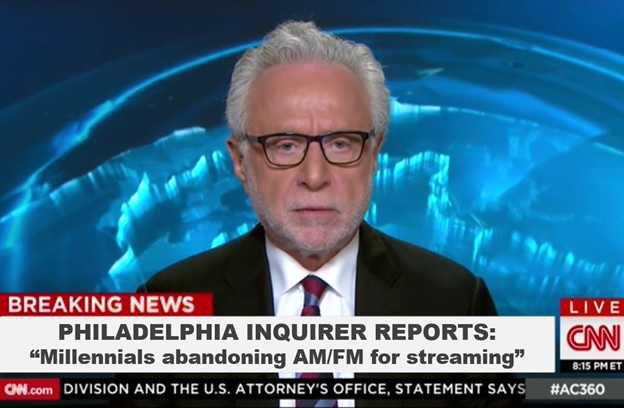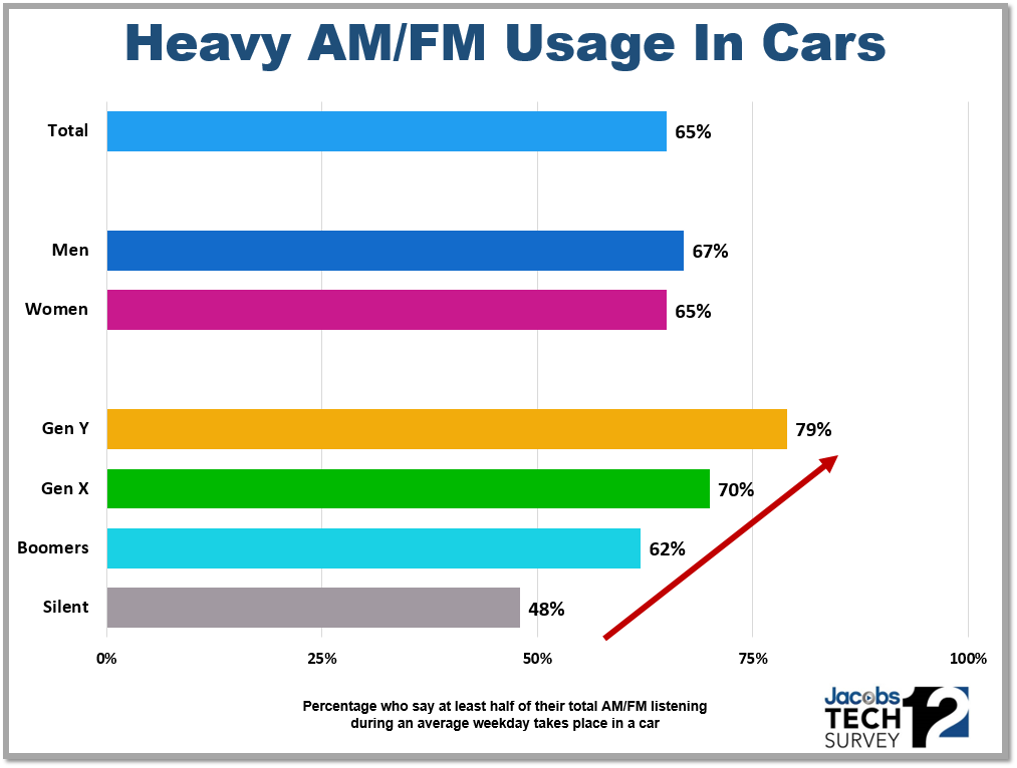
How’s that for an action headline? It’s enough to wake a radio guy up and get his attention. And that’s the effect it had on me when I ran across this story from the BBC written by Bryan Lufkin.
Like so many news items that start out on a hysterical note, this one actually calmed down quickly, providing a history of radio’s relationship with the automobile, as well as a smart analysis of the ever-crowded car dashboard. Lufkin talks about the rise of streaming, satellite radio’s growth, and the inevitability of autonomous cars.
And interestingly, while he suggests early on that “FM’s days might be numbered,” he concludes on an upbeat note for radio, quoting Chris Fangmann, director and CTO of Global Manufacturing Industry at the IT company CSC:
“I expect that ‘radio’ will remain being the primary form of in-car infotainment. But the radio itself will continue to change. It will leverage new services and will of course continue to be the early adopter for new technological disruptions (that) we don’t know of today.”
No argument here. Radio is still the easiest, most convenient choice that is still rooted in the habit structure of millions of drivers. The slow leak, of course, is among Millennials. And on that note came this equally alarming article that appeared over the weekend in the Philadelphia Inquirer blaring, “Millennials Abandoning AM/FM for Streaming” by Jonathan Takiff.

Takiff discusses a myriad of ominous issues impacting the radio industry, noting that car dashboards now provides a great deal of choice for button punchers, especially young people:
“A touchscreen display and hidden computer behind the dashboard of today’s modern rides make the skedaddling easy.”
While the Inquirer article lays out an ominous array of potential dashboard disruptors for radio, neither Takiff nor Lufkin even mention two of the most serious players – Apple CarPlay and Android Auto – those center stack ecosystems that promise to become the default systems in more and more new vehicles. The fact that the two largest tech companies in the world are vying for valuable dashboard real estate should be a strong indicator of the car’s long-term importance.
All this media noise and dire predictions of gloom and doom for broadcast radio keep coming back to the ever-crowded center stacks of the cars we drive or will be driving in the not-too-distant future. Given the dominance of the car as the core radio listening location, anything automotive ought to get our attention. Our own Techsurveys show the lion’s share of radio listening now takes place while consumers are on four wheels, especially among Millennials.

And for the radio industry, it should be a continued reminder that strategic planning, research and development, an action oriention, and a unified front are now necessary ingredients in addressing the automotive challenge head on.
The NAB is moving in this direction, bolstered by a national research study conducted by Magid that underscores the value of AM/FM radio to consumers when they’re in their cars. But trade associations like the NAB or the RAB can’t go it alone. The need for the broadcast radio industry to speak in one voice has never been more important. Connecting with the automotive industry is a challenging task to begin with – doing it radio company by radio company is inefficient and confusing, ensuring that positive messages will surely be lost in all the noise.
There’s also a need for broadcasters to begin viewing the dashboard as a programming challenge that has arisen because of in-car competition that includes pure-plays, satellite radio, podcasts – in short, everyone. All of this could be amplified in autonomous cars as “drivers” will be able to focus on the dash rather than the road, leaving time and space for new content options, including video.
On Tuesday, June 28, jācapps will be presenting “The Connected Car & Radio,” a free webinar that breaks down some of the key issues. I invite you to join us. We’ll be addressing all these issues and conditions, as well as the Apple and Google factor.
Since Jacobs Media first immersed itself at the intersection where radio and automotive meet back in 2009, our involvement in the space has been dedicated to bringing the two industries together. Our DASH Conferences have been all about fostering a sense of learning, cooperation, and understanding for both of these storied American institutions – radio and cars.
Next week, I’ll be making connected car presentations at both the New Jersey Broadcasters Association and the Virginia Association of Broadcasters conferences. It’s all about educating and engaging broadcasters about these challenges, and what they can do to affect change.
In the meantime, be wary of those sensational headlines. They’ll keep you up at night.
- Radio + Thanksgiving = Gratitude - November 27, 2024
- Is It Quittin’ Time For SiriusXM? - November 26, 2024
- Radio, It Oughta Be A Crime - November 25, 2024




We need to focus on where the puck is going (driverless), while using the connected car as a learning laboratory as you’ve been helping radio do since 2009.
We also need to aggressively define and share radio’s value proposition with listeners in the driverless space.
Unfortunately it is unlikely we will have another 7 years to prepare for driverless and the much larger disruption it will usher in. Next year, Volvo is giving 100 regular people in Sweden driverless cars.
More info https://www.volvocars.com/au/about/innovations/intellisafe/autopilot
Look forward to the webinar on June 28th.
Andrew, autonomous cars are on the horizon, and we’re coming up on them faster than anyone (including the OEMs) thought. They will play a role in media consumption, as you suggest. Thanks for the comment and the link.
I don’t believe driverless cars are “that” close to become a reality. They may become popular in smaller countries like Sweden but, the United States? I don’t think so. Many people in this country enjoy driving and that includes the feeling that goes along with it. It’s a feeling that wouldn’t be there if the car did all the work. Besides, would you really want to be driving in a heavy, populated area like New York or Los Angeles and “not” have control of your car? I just don’t see this as a reality that will come to fruition any time soon. Or even in the near future. Radio should be focused more on content and improving itself technically. A beautifully wrapped package loses all its luster when its opened and its discovered there’s nothing in it. Content is STILL important. Radio doesn’t need to worry about driverless cars. It should just keep its eyes on the road. Because that’s where everyone else’s will be.
Curt, we’re in lock-step agreement on the content piece. That has always been a core part of any radio/automotive discussion. As for consumer sentiment toward autonomous cars, you are correct that many people hate the idea of cars that drive themselves. Over the next several years, the auto companies will build in autonomous features (like driver assist features and warnings) that will get us accustomed to the experience. But it’s clearly coming. Thanks for the comment.
The BBC headline was sensationalist, and not even argued in the article! Unimportant.
But cars are important. Recent research shows that radio wins in morning drive; streaming wins the evening. To some extent the future of radio hinges on listener choice between linear listening (morning drive time especially) and linear listening (emerges at work and at home).
One real danger for radio in new cars is loss of ease. When the entire platform is reduced to one app among many on a screen, radio risks losing listeners simply because they can’t figure out how to turn it on. (Remember the Edison videos at the Orlando Radio Show in 2013?)
This issue might not be sufficiently addressed by radio, as a “…For Dummies” educational initiative. If I were a station manager, I would get this announcement in frequent rotation: “Buying a new car? You might be surprised that the radio is hard to find! But we’re still there, and we’re making it easy for you to stay with us. Go to WXYZ.com/cars, for everything you need to know.” That page would be informed by collateral from the NAB…which should have its hands deep into every iteration of CarPlay, Android Auto, and OEM_specific head units. Is the NAB vitally up to speed like that, and furnishing how-to content to stations? If not, why not? What’s more important than training users how to turn on the radio when the ON knob is disappearing?
Fred, I don’t disagree with your focus on content (though I’m not sure anything is happening in that regard. Where is AM/FM with podcasting? Is radio creating mountains of on-demand content to fill out the personalized/linear equation?) But radio is already highly differentiated, which Bouvard, NAB, et al love to point out. That doesn’t help if the user can’t figure out how to turn it on.
When you’re addicted to something that’s easy to get, and it suddenly becomes hard to get, there’s a crossroad. You either figure out how to get it, or you move on to something easier and fall in love with IT. That is radio’s danger, well documented by Edison studies of new-car buyers.
Radio has loyalty. Train those P1’s … before they inevitably upgrade their cars!
Brad, thanks for weighing in with several good thoughts. At DASH, we’ve continued to address all these issues – dealership training, showroom presence (Pandora and Sirius/XM are way ahead), etc. The challenge is educating the radio industry on the importance of the car (listening and advertising), and allying industry forces to work together to connect with automakers and drivers. The NAB commissioned a research study last year, and they are very motivated on this space. We’ve made progress these past few years, but as you accurately point out, the clock is ticking.